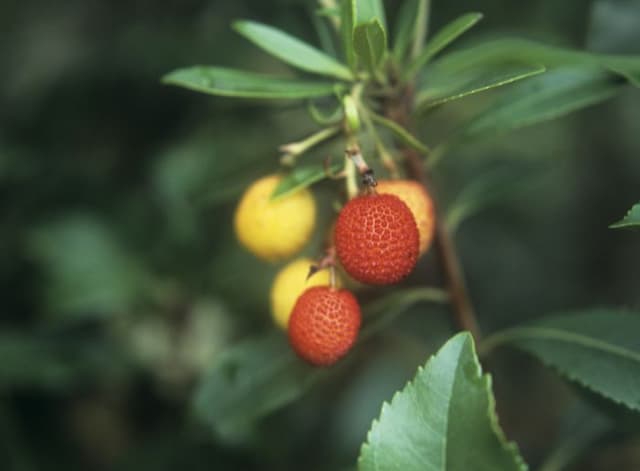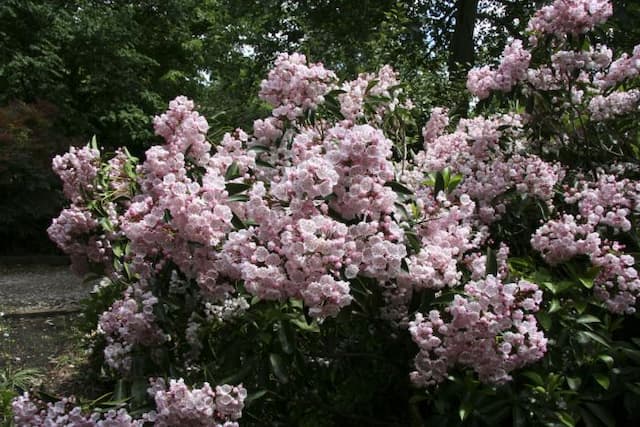Japanese Andromeda Pieris japonica 'Bonfire'

ABOUT
Pieris japonica 'Bonfire', commonly known as Japanese Andromeda 'Bonfire', is an evergreen shrub that boasts year-round visual interest. One of its most striking attributes is the vibrant red foliage that emerges in early spring, resembling a fiery blaze, hence the cultivar name 'Bonfire'. As the seasons progress, this fiery red foliage matures into a deep, glossy green, providing a rich backdrop for other garden plants. In late winter to early spring, just before the new foliage emerges, Japanese Andromeda 'Bonfire' produces cascades of bell-shaped flowers. These flowers are typically white and form drooping clusters that resemble lily-of-the-valley blooms—adding to the plant's ornamental appeal. The overall shape of Japanese Andromeda 'Bonfire' is compact and rounded, with a dense habit that makes it suitable for use as a foundation plant, in shrub borders, or even as an accent in landscape designs. Its leaves are elongated and leathery, contributing to its robust appearance. As an evergreen, it retains its foliage throughout the year, making it an excellent choice for adding winter interest to gardens. With its contrasting colors and interesting textures, Japanese Andromeda 'Bonfire' can be an eye-catching addition to any garden, providing year-round beauty without the need for constant care and attention. Its visual transformation from blazing red to lush green, combined with its graceful flowering, makes it a standout among garden plants.
About this plant
 Names
NamesFamily
Ericaceae.
Synonyms
Japanese Andromeda, Japanese Pieris, Lily-of-the-Valley Bush, Andromeda.
Common names
Pieris japonica 'Bonfire'.
 Toxicity
ToxicityTo humans
Japanese andromeda, which includes the cultivar 'Bonfire', is considered toxic to humans if ingested. The plant contains grayanotoxins, which can interfere with normal cell function and ion channels in the body. If someone eats parts of this plant, they may exhibit symptoms such as burning sensation in the mouth, excessive drooling, vomiting, diarrhea, weakness, decreased blood pressure, and possibly depression of the central nervous system. Severe poisoning, although rare, could lead to more profound medical issues, including coma or death if a significant amount is consumed without appropriate medical treatment.
To pets
Japanese andromeda is toxic to pets if ingested, containing grayanotoxins that can cause similar symptoms in animals as in humans. When a pet consumes parts of this plant, it may experience drooling, vomiting, diarrhea, decreased appetite, a drop in blood pressure, depression, weakness, and heart problems. Consumption of a large amount can cause severe poisoning and can be life-threatening for the animal, necessitating immediate veterinary attention.
 Characteristics
CharacteristicsLife cycle
Perennials
Foliage type
Evergreen
Color of leaves
Mixed
Flower color
White
Height
4-6 feet (1.2-1.8 meters)
Spread
2-4 feet (0.6-1.2 meters)
Plant type
Shrub
Hardiness zones
5-8
Native area
Japan
Benefits
 General Benefits
General Benefits- Ornamental Appeal: Pieris japonica 'Bonfire' features attractive reddish new foliage and cascades of white bell-shaped flowers in the spring, adding aesthetic value to gardens and landscapes.
- Year-Round Interest: With evergreen leaves and seasonal changes in foliage color, it provides visual interest throughout the year, unlike deciduous shrubs that lose their leaves in winter.
- Easy to Grow: It is relatively easy to care for, requiring minimal maintenance once established, making it suitable for gardeners of all skill levels.
- Pest Resistance: Pieris japonica 'Bonfire' is resilient to many common garden pests, reducing the need for chemical treatments.
- Drought Tolerance: Once established, the shrub has a moderate tolerance for drought, though it prefers consistent moisture.
- Shade Tolerance: It can thrive in partly shaded areas, where other sun-loving plants might struggle, offering flexibility in garden design.
- Wildlife Attraction: The flowers provide nectar for pollinators such as bees in early spring, supporting local ecosystems.
 Medical Properties
Medical PropertiesThis plant is not used for medical purposes.
 Air-purifying Qualities
Air-purifying QualitiesThis plant is not specifically known for air purifying qualities.
 Other Uses
Other Uses- Pieris japonica 'Bonfire', commonly known as Japanese Andromeda, can be used in creating bonsai due to its slow growth habit and aesthetically pleasing foliage.
- The colorful new growth of Japanese Andromeda can be utilized in flower arrangements as an interesting foliage contrast, especially in spring.
- Due to its resistance to honey fungus, it can be strategically placed in gardens where previous plants have succumbed to the disease, providing a more resilient landscape feature.
- It can be used as a natural screen or hedge, especially in areas with partial shade, where other hedging plants might struggle to thrive.
- In areas susceptible to deer browsing, Japanese Andromeda is considered deer-resistant, making it a practical choice for landscapes frequented by wildlife.
- Its dense evergreen foliage makes it an ideal backdrop for highlighting the blooms of other more vibrant flowers in a mixed border.
- In coastal gardens, the Pieris japonica 'Bonfire' can be employed due to its tolerance of salt spray, offering reliable evergreen structure.
- Japanese Andromeda is sometimes used in thematic gardens to represent Japanese culture or to complement a Japanese aesthetic.
- The plant can be included in butterfly gardens as its flowers are known to attract pollinators like bees and provide nectar sources in the spring.
- It can be planted near patios or outdoor seating areas as its evergreen leaves and seasonal flowers add to the overall ambiance of outdoor living spaces.
Interesting Facts
 Feng Shui
Feng ShuiThe Japanese Andromeda is not used in Feng Shui practice.
 Zodiac Sign Compitability
Zodiac Sign CompitabilityThe Japanese Andromeda is not used in astrology practice.
 Plant Symbolism
Plant Symbolism- Renewal and New Beginnings - Pieris japonica 'Bonfire', also known as Japanese Andromeda, often signals the start of spring as it blooms with vibrant red foliage, symbolizing a fresh start or rebirth.
- Purity and Innocence - The delicate white flowers that emerge following the fiery red foliage are often associated with purity and innocence, akin to the serene beauty found in many traditional Japanese gardens.
- Protection - In some cultures, the evergreen nature of Japanese Andromeda symbolizes protection and steadfastness, as the plant remains vibrant throughout the seasons.
- Beauty and Aesthetics - With its striking colors and elegant form, Pieris japonica 'Bonfire' represents beauty and the appreciation of aesthetic qualities inherent in nature.
- Adaptability - As a tough plant that can adapt to many environments, Japanese Andromeda can also symbolize resilience and the ability to thrive amidst changing conditions.
 Water
WaterJapanese Andromeda requires consistent moisture but should not be overwatered. Water it thoroughly when the top inch of soil feels dry, typically every week or so, depending on weather conditions. Provide the plant with about 1 to 1.5 gallons per watering for a medium-sized shrub to ensure it reaches the root zone. During the growing season in spring and summer, you may need to water more frequently, especially if the weather is particularly hot or dry. Reduce watering in the fall and further in winter when the plant's water needs decrease.
 Light
LightJapanese Andromeda thrives in partial shade to full sun, but in hotter regions, it prefers being protected from the intense afternoon sun. The ideal spot for this plant is somewhere with morning sunlight and afternoon shade to prevent leaf scorch. A spot that receives filtered light throughout the day would also be beneficial for the vibrant foliage and flower development.
 Temperature
TemperatureJapanese Andromeda does well in a range of temperature conditions and can survive winter temperatures down to about 0 degrees Fahrenheit. The ideal temperature range for this plant is between 60 and 80 degrees Fahrenheit, but it is quite hardy and can tolerate colder winter temperatures well. It's important to protect the plant from harsh winter winds, especially in colder zones on the lower end of its hardiness range.
 Pruning
PruningPrune Japanese Andromeda to maintain shape and remove any dead or damaged branches. The best time to prune is right after the plant has finished flowering in the spring to avoid cutting off next year's buds. Pruning can be done annually, but this plant typically has a naturally attractive shape and may not need much pruning if it's growing well.
 Cleaning
CleaningAs needed
 Soil
SoilJapanese Andromeda 'Bonfire' thrives in acidic, well-draining soil rich in organic matter. A mixture of peat moss, pine bark, and garden soil in equal parts can create an ideal environment. The soil pH should ideally be between 4.5 to 6.0.
 Repotting
RepottingJapanese Andromeda 'Bonfire' should be repotted every 2 to 3 years or when it becomes root-bound. Spring is the optimal time for repotting to allow the plant to recover during the growing season.
 Humidity & Misting
Humidity & MistingJapanese Andromeda 'Bonfire' prefers moderate to high humidity levels, ideally between 50% and 60%. It benefits from occasional misting or a nearby humidifier if the indoor air is dry.
 Suitable locations
Suitable locationsIndoor
Provide bright, indirect light and maintain soil moisture.
Outdoor
Plant in partial shade, protect from harsh sun and wind.
Hardiness zone
5-8 USDA
 Life cycle
Life cycleThe common name for Pieris japonica 'Bonfire' is Japanese Andromeda 'Bonfire'. The life cycle begins with germination, where the plant emerges from seeds, usually in the spring. As a young plant, it develops its root system and first leaves, gradually maturing into a bush with distinctive bronze-colored new foliage that turns green with age. Throughout late winter to early spring, Japanese Andromeda 'Bonfire' enters its flowering stage, producing cascades of bell-shaped, white to pink flowers. Post-flowering, the plant sets seeds contained within small capsules, which, when mature, open to disperse seeds for the next generation. The plant then continues its growth as an evergreen shrub, maintaining its foliage year-round until it becomes dormant in the colder winter months, conserving resources for the next cycle.
 Propogation
PropogationPropogation time
Spring-Early Summer
Propogation: The most popular method of propagating the Japanese Andromeda 'Bonfire' is through softwood cuttings, which is typically done in late spring or early summer when the plant's new growth is just beginning to harden but is still flexible. To propagate using this method, a gardener would cut a piece of the plant that is about 4 to 6 inches long (10 to 15 centimeters), making sure that there are several leaves on the cutting and that it is taken just below a leaf node. The lower leaves should be removed, and the cut end dipped into a rooting hormone to encourage root growth. The prepared cutting can then be placed into a well-draining potting mix, ensuring that the leaf nodes where the leaves were removed are buried in the soil. The cutting should be watered well and then covered with a plastic bag or placed in a greenhouse with high humidity to help retain moisture and warmth, which will encourage rooting. Roots typically develop in several weeks, after which the new plants can be gradually acclimated to less humid conditions and eventually transplanted outdoors.









